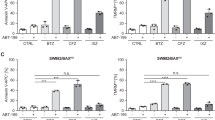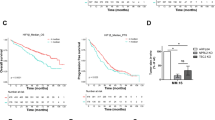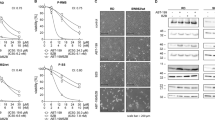Abstract
Inhibition of p38 kinase blocks the production of tumor-promoting factors in the multiple myeloma (MM) bone marrow microenvironment. Proteasome inhibitors MG132 and bortezomib have been shown to have direct cytotoxic effects on MM cells. We show that a selective inhibitor of p38α, SCIO-469, enhances the ability of MG132 and bortezomib to induce the apoptosis of MM cells. Previously, we showed that p38 inhibition with SCIO-469 enhances MM cytotoxicity of bortezomib by inhibiting the transient expression and phosphorylation of Hsp27, a downstream target of p38. Here we show that continued treatment of MM cells with bortezomib leads to a SCIO-469-enhanced downregulation of Hsp27 and to increased MM apoptosis. Furthermore, we show that p38 inhibition enhances the bortezomib-induced MM apoptosis by upregulation of p53 and downregulation of Bcl-XL and Mcl-1. In a mouse xenograft plasmacytoma model of MM, we found that inhibiting p38 augments the effects of bortezomib in decreasing MM tumor growth in vivo. Thus, in addition to its role in suppressing an activated MM microenvironment, co-treatment with a p38 inhibitor, such as SCIO-469, may enhance the cytotoxicity of bortezomib by modulating pro-apoptotic and anti-apoptotic factors in MM cells, suggesting great potential for co-therapy.
This is a preview of subscription content, access via your institution
Access options
Subscribe to this journal
Receive 12 print issues and online access
$259.00 per year
only $21.58 per issue
Buy this article
- Purchase on Springer Link
- Instant access to full article PDF
Prices may be subject to local taxes which are calculated during checkout







Similar content being viewed by others
References
Hideshima T, Richardson P, Anderson KC . Novel therapeutic approaches for multiple myeloma. Immunol Rev 2003; 51: 164–166.
Uchiyama H, Barut BA, Mohrbacher AF, Chauhan D, Anderson KC . Adhesion of human myeloma-derived cell lines to bone marrow stromal cells stimulates interleukin-6 secretion. Blood 1993; 82: 3712–3720.
Podar K, Tai YT, Davies FE, Lentzsch S, Sattler M, Hideshima T et al. Vascular endothelial growth factor triggers signaling cascades mediating multiple myeloma cell growth and migration. Blood 2001; 98: 428–435.
Lee JC, Young PR . Role of CSB/p38/RK stress response kinase in LPS and cytokine signaling mechanisms. Leukocyte Biol 1996; 59: 152–157.
Hideshima T, Akiyama M, Hayashi T, Richardson P, Schlossman R, Chauhan D et al. Targeting p38 MAPK inhibits multiple myeloma cell growth in the bone marrow milieu. Blood 2003; 101: 703–705.
Matsumoto M, Sudo T, Saito T, Osada H, Tsujimoto M . Involvement of p38 mitogen-activated protein kinase signaling pathway in osteoclastogenesis mediated by receptor activator of NF-kappa B ligand (RANKL). J Biol Chem 2000; 40: 31155–31161.
Hideshima T, Podar K, Chauhan D, Ishitsuka K, Mitsiades C, Tai YT et al. p38 MAPK inhibition enhances bortezomib (bortezomib)-induced cytotoxicity against multiple myeloma cells. Oncogene 2004; 23: 8766–8776.
Concannon CG, Gorman AM, Samali A . On the role of Hsp27 in regulating apoptosis. Apoptosis 2003; 8: 61–70.
Stokoe D, Engel K, Campbell DG, Cohen P, Gaestel M . Identification of MAPKAP kinase 2 as a major enzyme responsible for the phosphorylation of the small mammalian heat shock proteins. FEBS Lett 1992; 313: 307–313.
Chauhan D, Li G, Hideshima T, Podar K, Mitsiades C, Mitsiades N et al. Hsp27 inhibits release of mitochondrial protein Smac in multiple myeloma cells and confers dexamethasone resistance. Blood 2003; 102: 3379–3386.
Chauhan D, Li G, Podar K, Hideshima T, Shringarpure R, Catley L et al. Blockade of Hsp27 overcomes Bortezomib/proteasome inhibitor bortezomib resistance in lymphoma cells. Cancer Res 2003; 63: 6174–6177.
Mitsiades N, Mitsiades CS, Richardson PG, McMullan C, Poulaki V, Fanourakis G et al. Molecular sequelae of proteasome inhibition in human multiple myeloma cells. Proc Natl Acad Sci USA 2002; 99: 14374–14379.
Cory S, Huang DCS, Adams JM . The Bcl-2 family: roles in cell survival and oncogenesis. Oncogene 2003; 22: 8590–8607.
Spets H, Stromberg T, Georgii-Hemming P, Siljason J, Nilsson K, Jernberg-Wiklund H . Expression of the Bcl-2 family of pro- and anti-apoptotic genes in multiple myeloma and normal plasma cells: regulation during interleukin 6 (IL-6)-induced growth and survival. Eur J Haematol 2002; 69: 76–89.
Gauthier ER, Piche L, Lemieux G, Lemieux R . Role of bcl-X(L) in the control of apoptosis in murine myeloma cells. Cancer Res 1996; 56: 1451–1456.
Wuilleme-Toumi S, Robillard N, Gomez P, Moreau P, Le Gouill S, Avet-Loiseau H et al. Mcl-1 is overexpressed in multiple myeloma and associated with relapse and shorter survival. Leukemia 2005; 19: 1248–1252.
Derenne S, Monia B, Dean NM, Taylor JK, Rapp MJ, Harousseau JL et al. Antisense strategy shows that Mcl-1 rather than Bcl-2 or Bcl-x(L) is an essential survival protein of human myeloma cells. Blood 2002; 100: 194–199.
Tu Y, Renner S, Xu F, Fleishman A, Taylor J, Weisz J et al. BCL-X expression in multiple myeloma: possible indicator of chemoresistance. Cancer Res 1998; 58: 256–262.
Kimata H . GM1, a ganglioside that specifically enhances immunoglobulin production and proliferation in human plasma cells. Eur J Immunol 1994; 24: 2910–2913.
Kisselev AF, Goldberg AL . Proteasome inhibitors: from research tools to drug candidates. Chem Biol 2001; 8: 739–758.
Michels J, O'Neill JW, Dallman CL, Mouzakiti A, Habens F, Brimmell M et al. Mcl-1 is required for Akata6 B-lymphoma cell survival and is converted to a cell death molecule by efficient caspase-mediated cleavage. Oncogene 2004; 23: 4818–4827.
Richardson PG, Hideshima T, Anderson KC . Bortezomib (PS-341): a novel, first-in-class proteasome inhibitor for the treatment of multiple myeloma and other cancers. Cancer Control 2003; 10: 361–369.
Elenitoba-Johnson KS, Jenson SD, Abbott RT, Palais RA, Bohling SD, Lin Z et al. Involvement of multiple signaling pathways in follicular lymphoma transformation: p38-mitogen-activated protein kinase as a target for therapy. Proc Natl Acad Sci USA 2003; 100: 7259–7264.
Karahashi H, Nagata K, Ishii K, Amano F . A selective inhibitor of p38 MAP kinase, SB202190, induced apoptotic cell death of a lipopolysaccharide-treated macrophage-like cell line, J774.1. Biochem Biophys Acta 2000; 1502: 207–223.
Nguyn AN, Stebbins EG, Henson M, O'Young G, Choi SJ, Quon D et al. Normalizing the bone marrow microenvironment with p38 inhibitor reduces multiple myeloma cell proliferation and adhesion and suppresses ostoclast formation. Exp Cell Res 2006, (in press).
Hideshima T, Mitsiades C, Akiyama M, Hayashi T, Chauhan D, Richardson P et al. Molecular mechanisms mediating antimyeloma activity of proteasome inhibitor PS-341. Blood 2003; 101: 1530–1534.
Silvestris F, Tucci M, Cafforio P, Dammacco F . Fas-L upregulation by highly malignant myeloma plasma cells: role in the pathogenesis of anemia and disease progression. Blood 2001; 97: 1155–1164.
Le Gouill S, Podar K, Harousseau JL, Anderson KC . Mcl-1 regulation and its role in multiple myeloma. Cell Cycle 2004; 3: 1259–1262.
Bachelor MA, Bowden GT . Ultraviolet A-induced modulation of Bcl-XL by p38 MAPK in human keratinocytes. J Biol Chem 2004; 279: 42658–42668.
Niwa M, Hotta K, Kanamori Y, Hatakeyama D, Hirade K, Katayama M et al. Involvement of p38 mitogen-activated protein kinase in heat shock protein 27 induction in human neutrophils. Eur J Pharmacol 2003; 466: 245–253.
Leuenroth SJ, Grutkoski PS, Ayala A, Simms HH . Suppression of PMN apoptosis by hypoxia is dependent on Mcl-1 and MAPK activity. Surgery 2000; 128: 171–177.
Villunger A, Michalak EM, Coultas L, Mullauer F, Bock G, Ausserlechner MJ et al. p53- and drug-induced apoptotic responses mediated by BH3-only proteins puma and noxa. Science 2003; 302: 1036–1038.
Liu FT, Newland AC, Jia L . Bax conformational change is a crucial step for puma-mediated apoptosis in human leukemia. Biochem Biophys Res Commun 2003; 310: 956–962.
Mackus WJ, Kater AP, Grummels A, Evers LM, Hooijbrink B, Kramer MH et al. Chronic lymphocytic leukemia cells display p53-dependent drug-induced Puma upregulation. Leukemia 2005; 19: 427–434.
Adams JM . Ways of dying: multiple pathways to apoptosis. Genes Dev 2003; 17: 2481–2495.
Acknowledgements
We thank Richard Brewer, former President of Scios Inc., for his heartfelt support and inspiration for this project. All of the authors, except TH and KCA, are employed by Scios Inc., where SCIO-469, a potential product, was studied in the present work. This paper has not been submitted elsewhere while under consideration for Leukemia.
Author information
Authors and Affiliations
Corresponding author
Additional information
Supplementary Information accompanies the paper on the Leukemia website (http://www.nature.com/leu)
Rights and permissions
About this article
Cite this article
Navas, T., Nguyen, A., Hideshima, T. et al. Inhibition of p38α MAPK enhances proteasome inhibitor-induced apoptosis of myeloma cells by modulating Hsp27, Bcl-XL, Mcl-1 and p53 levels in vitro and inhibits tumor growth in vivo. Leukemia 20, 1017–1027 (2006). https://doi.org/10.1038/sj.leu.2404200
Received:
Revised:
Accepted:
Published:
Issue Date:
DOI: https://doi.org/10.1038/sj.leu.2404200
Keywords
This article is cited by
-
A Central Role for Phosphorylated p38α in Linking Proteasome Inhibition-Induced Apoptosis and Autophagy
Molecular Neurobiology (2017)
-
Tracking human multiple myeloma xenografts in NOD-Rag-1/IL-2 receptor gamma chain-null mice with the novel biomarker AKAP-4
BMC Cancer (2011)
-
The regulatory crosstalk between kinases and proteases in cancer
Nature Reviews Cancer (2010)
-
Bax is upregulated by p53 signal pathway in the SPE B-induced apoptosis
Molecular and Cellular Biochemistry (2010)
-
Bortezomib-mediated expression of p27Kip1 through S-phase kinase protein 2 degradation in epithelial ovarian cancer
Laboratory Investigation (2009)



